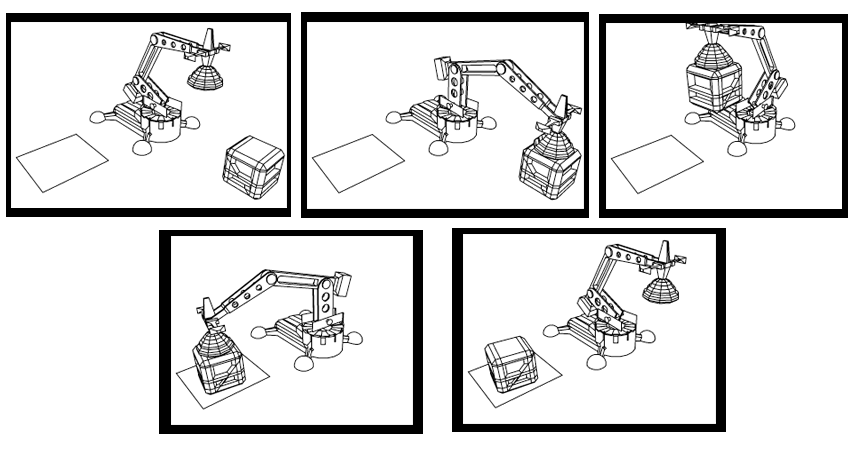Now that the mechanical arm and cargo box are fully set up for animation it’s a simple matter to pose the arm and set keyframes. Prior to setting any keyframes you should take a few moments to plan the action for the scene.
Planning the action usually involves sketching a simple storyboard, and writing out a brief timeline for the action for each component. In this lesson we’ve provided a simple version for you. The basic premise for the action is as follows:

- The cargo box is positioned directly in front of the mechanical arm.
- The mechanical arm extends, and positions the cargo magnet to be directly touching the top of the cargo box.
- The mechanical arm extends upwards, lifting the cargo box, and rotates to the side.
- The mechanical arm lowers the box, placing it in a new position.
- The mechanical arm extends upwards, leaves the cargo box in the new location, and rotates back to its original position.
The table below breaks down the action indicating what action occurs for each object at the specified keyframes.
| Frame | Mechanical Arm | Cargo Box |
|---|---|---|
|
1 |
Collapsed position |
Initial position |
|
30 |
Vertically extended position |
Initial position |
|
60 |
Vertically lowered so that cargo magnet is positioned on top of cargo box |
Initial position |
|
80 |
Vertically lifted to extended position with cargo box |
Cargo box lifted with mechanical arm |
|
100 |
SwivelBase rotated along with arm to side |
Cargo box repositioned along with mechanical arm |
|
120 |
Vertically lowered along with cargo box to second position above surface |
Cargo box is lowered along with mechanical arm to second position |
|
140 |
Vertically lifted to extended position |
Second position |
|
160 |
SwivelBase rotated with arm to original position |
Second position |
|
180 |
Collapsed position |
Second position |
To pose the mechanical arm you select either the ArmControl or SwivelBase nodes and set a keyframe depending on which component you want to pose:
- ArmControl controls the movement of the mechanical arm.
- SwivelBase controls the rotation of the arm.
- CargoBox’s position is based on the parent constraint weights.